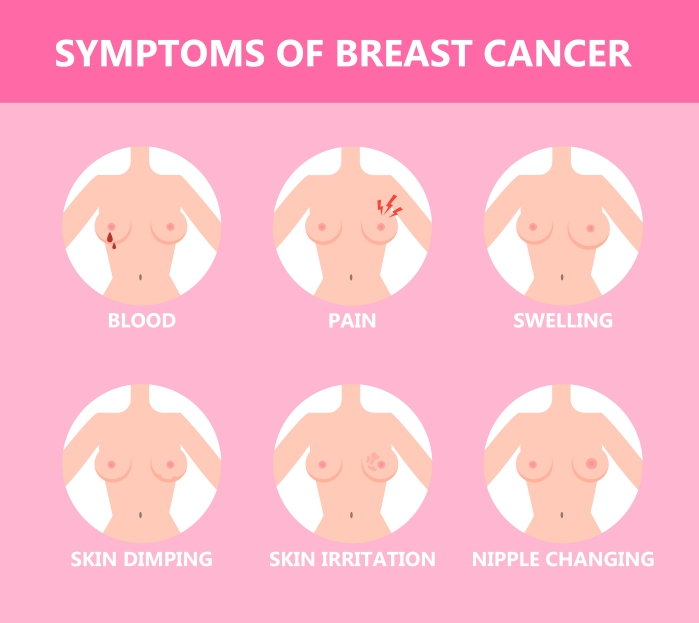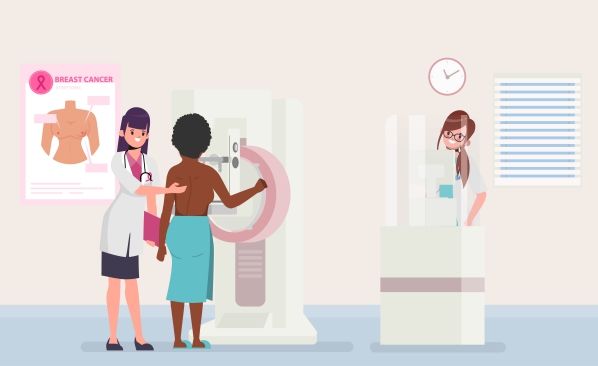What is breast cancer?
Breast Cancer is a cancer that affects the breast cells. The cancer can either develop in the ducts or lobules of the breast. The lobules are the glands that produce milk and the ducts are the channel through which milk reaches the nipple. Cancer cells can spread via the lymph nodes, located under the arms.
Breast cancer is the second most common cancer in women in the United States. 95% of new cases occur in women above the age of 40 years. Furthermore, it is more common in non-hispanic whites. In addition, women are more at risk of developing breast cancer than men.
If breast cancer is detected early, it has a very good prognosis. That is why women should have regular check-ups at their doctor’s office to screen for breast cancer.
What are the risk factors for breast cancer?
There are several factors which increases your risk of developing breast cancer including:
- Family history of breast cancer
- Being female
- Having breast cancer in one breast, increases your risk of developing it in the other breast
- Increasing age
- Certain inherited genes such as BRCA1 and BRCA2
- Being exposed to radiation
- Obesity
- Early menarche
- Late menopause
- Having no children or have had children at an older age
- Excess alcohol consumption
- Hormonal therapy

What are the signs and symptoms of breast cancer?
Early stage breast cancer usually does not cause any symptoms. However, as the cancer continues to grow the following signs and symptoms may arise:
- Breast mass: it is usually a hard and immobile mass with irregular borders.
- Lump in the axilla.
- Redness, thickening and enlargement of the breast (peau d’orange appearance).
- Breast tenderness.
- Nipple discharge other than milk.
- Bloody discharge from breast.
- Nipple inversion.
Making a diagnosis
Your doctor will first take a detailed history from you to know more about your symptoms. This is usually followed by a physical examination whereby your doctor will examine your breast for any mass, nipple discharge or any other abnormality. He/she will also check under your arms for any lump.
Your doctor can order imaging tests to help diagnose breast cancer, these include:
- Mammography: this test is mainly used for women aged above 35 years. It will allow your doctor to get additional information about the mass in your breast and see if it has any malignant features.
- Ultrasound: this test is mainly used in women aged below 35 years. It will allow your doctor to differentiate between a solid or cystic mass.

If after the imaging tests your doctor still suspects breast cancer, then he/she may order a breast biopsy. It involves your doctor removing a piece of the breast mass using a needle. The samples obtained are sent to the laboratory to confirm the diagnosis or even stage the breast cancer.
What are the treatment options for breast cancer?
The treatment of breast cancer depends on the staging of the cancer. If the cancer was detected by screening and there are no symptoms, it is more likely to be an early stage cancer. However, when symptoms are present, the cancer may be at a later stage. The types of treatment include surgery, chemotherapy, radiotherapy, hormonal or targeted therapy.
Surgical management
There are mainly 2 types of surgeries that can be done:
- Breast conserving therapy: this type of surgery can be subdivided into lumpectomy (removal of a small mass), wide local excision (removal of the mass plus a little surrounding tissues) and quandrantectomy (up to one quarter of the breast is removed). Radiotherapy is usually given after surgery to kill the remaining cancer cells.
- Mastectomy: this is the removal of the whole breast, including the nipple. After mastectomy, reconstruction surgery may be offered for cosmetic purposes. If the cancer has spread to the lymph nodes, extensive lymph node removal surgery is done.

Radiotherapy
Radiotherapy kills cancer cells by using controlled doses of radiation. It is usually used as an adjunct after surgery and chemotherapy to kill any remaining cancer cells. Side effects of radiotherapy include irritation, darkening, sore and red breast skin.
Chemotherapy
Chemotherapy uses cytotoxic (anti-cancer) drugs to kill cancer cells. Chemotherapy can be used before surgery to reduce the size of the tumour or after surgery to kill the remaining cancer cells. Side effects of chemotherapy include loss of appetite, tiredness, hair loss or feeling sick.
Hormone therapy
There are some tumour which are sensitive to hormones, these are called hormone receptor-positive cancers. These cancers tend to grow larger and faster when stimulated by these hormones. Hormone therapy lowers the levels of hormones in your body thereby limiting cancer growth. This kind of treatment is especially useful in people who cannot undergo surgery, chemotherapy or radiotherapy. Tamoxifen is used to block the effects of oestrogen in breast tissue.
Targeted therapy

This type of treatment change the way cells work, in an attempt to help stop the progression of the cancer. Trastuzumab is an example. Side effects include headache, diarrhoea, cough and skin rash.
Complications of breast cancer
If breast cancer is left untreated, serious complications may arise. One of the most dreaded complication of breast cancer is metastasis. This is when the cancer spreads to the bones, lungs, liver, lymph nodes and brain resulting in catastrophic consequences. Complications may be due to surgery as well such as wound infection or swelling of the arm following lymph node removal.
Prevention
There are several steps that can be taken to prevent breast cancer, thee include:
- Breast cancer screening: women above the age of 40 years are encouraged to visit their doctor’s office annually for breast cancer screening.
- Breast self-examination.
- Avoid excess alcohol consumption.
- Regular physical exercises
- Limit post-menopausal hormone therapy.
- Adopt a healthy diet and weight.
Prognosis
In the United States, from 1990 to 2015, the death rate for breast cancer decreased by 40%. This is due to early detection and improved treatment strategies. The best way to protect your breast from breast cancer is to enrol in breast cancer screening programs.

Source:
Parveen, K. and Michael, C., 2017. Kumar & Clark’s Clinical Medicine. 9th ed. The Netherlands: ELSEVIER.
NHS. 2020. Breast cancer.
Medscape. 2020. Breast Cancer.












